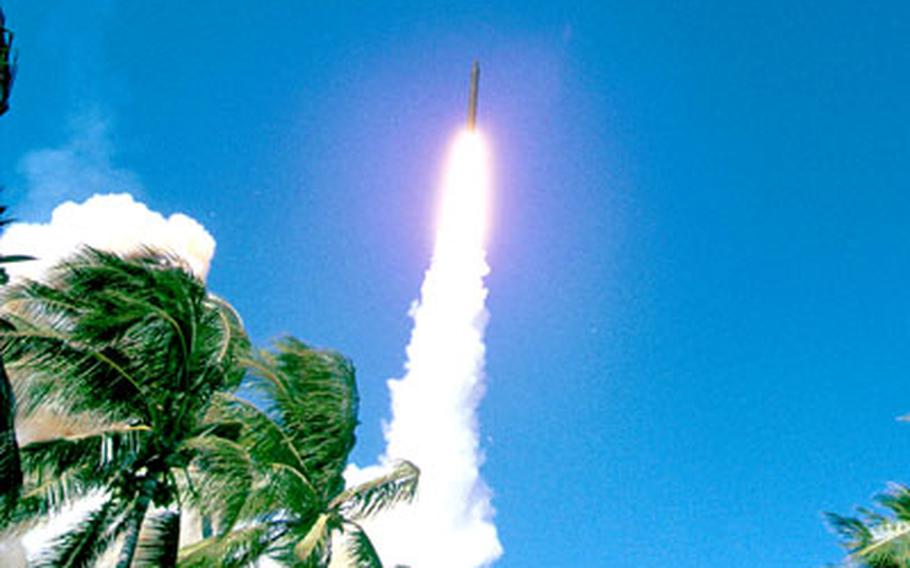
An interceptor missile rockets into the sky in a test launch. (Courtesy of the Missile Defense Agency)
TOKYO — Among sweeping changes called for in an interim U.S.-Japan military realignment report, the two countries are on a trajectory to place a massive new missile detection radar system in Japan.
The details of when and where the system will be based are being decided, but the report, issued in October, indicates a pivotal change in the countries’ approach to missile defense technology is in the works.
The new Forward-Based X-Band radar will form part of a web of surveillance designed to find and help destroy an enemy incoming ballistic missile. It also intricately aligns the two nations and nudges them toward closer cooperation, information-sharing and potentially a joint ballistic defense system, officials say.
“Missile capabilities in the region are certainly real. So it makes sense that the government of Japan, in partnership with the U.S. government, move forward on ballistic missile defense development,” U.S. Forces Japan officials said in a written statement.
A final realignment report, expected to contain more specifics, is due this spring.
The idea for missile defense gained momentum in both Japan and the United States in 1998 after North Korea launched a Taepodong missile over Japan.
Technology since has raised the risk: A missile launched today by China, North Korea, Iran, Syria, a rogue state or terrorist organization could devastate Seoul, Tokyo, Honolulu or, potentially, San Francisco and beyond.
Defense analysts suggest the only way to counter the threat, economically and technologically, is through partnerships with other countries, especially Japan.
But the cooperation has its critics, notably China, where officials said the alignment blurs the line between self-defense, allowed in Japan’s constitution, and mutual defense by participating in the U.S. missile defense system. Opposition politicians in Japan have echoed that position.
Before the October report, Japan’s cabinet altered its national stance on weapons research in order to allow more missile defense technology development.
Japanese leaders point to security as validation. When plans for Japan’s missile defense system were announced in 2003, Chief Cabinet Secretary Yasuo Fukuda told reporters such a system “is the only and purely defensive measure, without alternatives, to protect life and property of the citizens of Japan against ballistic missile attacks.”
Ready for new radarsThe two countries have shared research and technology in the past and signed a memorandum of understanding on missile defense cooperation in 2004, but the October report recommended not only a tangible example of the cooperation but signaled both sides’ willingness to move forward.
The new X-Band radar is one of three the Pentagon plans to place in allied countries, Chris Taylor, a Missile Defense Agency (MDA) spokesman, wrote in an e-mail.
In January, the Pentagon deployed a similar but larger radar system, a massive floating ocean-going radar called Sea Based X-Band. From its main base in Adak, Alaska, it will operate around the Pacific.
The X-Band radars are capable of differentiating missiles from decoys as well as tracking their trajectory in the stratosphere, according to the Missile Defense Agency. They augment radars on U.S. and Japanese Aegis warships, the latter of which began scanning for missiles in the Sea of Japan in 2004, according to Navy reports.
The radar systems will join one Japan is developing called “FPS-XX,” which it hopes to deploy by fiscal 2011, according to a Defense Department report released in 2005 White Papers on Japan’s defense.
Together, the systems allow a new level of shared surveillance. But they are only a piece of the missile defense plan.
Missiles in the mix, tooOn the other side is the interceptor missiles that will respond when sensors detect incoming missiles, according to the MDA.
In additional to lower altitude missiles such as the Patriot Missile used in the Gulf War, the modern U.S. missile defense system relies on higher altitude interceptor missiles designed to hit and destroy incoming ballistic missiles in the stratosphere. They have had only limited success in testing so far.
Interceptor missiles are positioned at Fort Greely, Alaska, and at Vandenberg Air Force Base, Calif., according to the MDA.
Japan and the United States also are working jointly on a similar sea-based interceptor that would deploy on ships, according to Japanese government reports.
Besides the technology, the October agreement also committed both countries to working more closely in their missile defense command and control, the heart and brains of the operation.
Although both governments laud the joint effort, changes have been slow and carry with them political turmoil in Japan.
But leaders on both sides believe shared anti-missile defense is key.
“What senior government of Japan officials recognize is how important the sharing of intelligence is,” U.S. Forces Japan commander Gen. Bruce Wright told reporters in January. “In this world with in the challenges facing us especially in the area of global terrorism, it’s very important that we cooperate even better.”
Staff writer Hana Kusumoto contributed to this report.
A guide to missile defense
Attack missile launches fall into three phases and the missile defense system has defenses for each. Read more